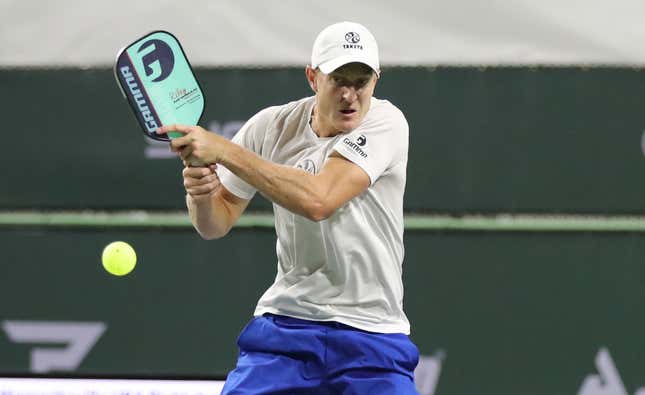
In a sign that ESPN and other networks can choose to devote broadcast hours to new and emerging sports, the American sports cable channel announced that it was adding pickleball to the lineup.
Pickleball, the racquetball of our era, is Crossfit without the tattoos and supplements. A sport that takes abandoned tennis courts and repurposes them as ping-pong Coliseums. It’s barely even a professional sport at this point, but here you have the broadcast deal.
The details: CBS Sports will show 12 hours of matches and highlights, and ESPN will have eight hours of action and recaps on ESPN2 plus 200 hours of coverage on the streaming platform.
But what about women’s sports?
Full disclosure, I don’t really mind pickleball. And I don’t actually begrudge the new league a broadcast contract and additional exposure. But that’s not the only young league that has landed a broadcast window. LIV Golf also announced a broadcast deal with the CW Network after the usual sports outlets passed.
The point here is that sports networks often take a flier on young sports leagues. As long as those leagues are men’s. In fact, what might be most notable about pickleball is that the Association of Pickleball Professionals has women’s divisions.
“But Jane,” you might say, “look how many people are playing pickleball!”
And to that I would answer, wait until you hear how many girls play soccer in this country. And yet the U.S. Women’s National Team game vs. New Zealand was not broadcast on a traditional sports network, it was shown on HBO Max.
“Pickleball has celebrity owners!”
And you should see the lineup for the National Women’s Soccer League — Serena Williams, Naomi Osaka, Natalie Portman, Sarah Spain, Mia Hamm… Women are investing in their own games like never before.
Slow to embrace coverage of women’s sports
American sports broadcasters have been slow to embrace women’s sports coverage. Even when they have been broadcast, networks haven’t built a suite of programming around those properties, like pre- and post-game shows or weekly roundups. Despite being one of the better networks in this regard, ESPN hasn’t had a women’s sports-specific recurring program on the network. This NFL Insiders for the WNBA or women’s tennis. Several studies also note how infrequently traditional sports outlets include women’s sports, with estimates ranging from four to six percent. Considering that U.S. women have been dominant in tennis for two decades, it’s a huge missed opportunity to cover the WTA as a sport, rather than cover individuals like Serena and Venus Williams, Naomi Osaka, and those who came before.
So, as Kathleen Schmidt, a public relations executive, tweeted on Monday:
May pickleball find all the success, but the announcement is more proof that traditional sports networks are gatekeepers that effectively marginalize women’s sports. Let’s take baseball. MLB has an average fan that is well in his 50s. The audience is aging and shrinking even as the architecture of sports coverage remains the same. Meanwhile, look at women’s basketball both professional and college. You have younger fans and a potential for more audience growth.
“It seems like the incremental progress gets a lot of attention,” said The Athletic’s Bill Shea, who writes about the business of sports. “We’re still in a ramp-up period that we probably should have been through years ago.”
The truth is that a bulk of the pickleball deal is on ESPN’s streaming platform. That’s a low-risk way for a network to try out a sport and see how it does, Shea said. Many streaming numbers aren’t released publically and there isn’t a standard way of noting them, so it isn’t clear what the comparable audiences are across platforms and leagues.
“We’re in such a chaotic era for coverage of sports with cord-cutting,” Shea said, “because the model is basically collapsing.”
The audience is there
Women’s sports have surged in interest in the last decade. U.S. women’s soccer routinely outperforms the men’s game in the World Cup. Serena Williams can pull 4.8 million viewers to the U.S. Open, and the NCAA women’s tournament has about the same size audience for the finals. Those are strong audiences in the era of viewer fragmentation, and they are improving year to year.
But women’s sports waiting for their due since before the era of televised poker are still waiting. Cornhole, beer pong… broadcast sports are about not disturbing an audience of young men more than they are about actually broadcasting sports.
Women in the sports audience have been growing, and now account for 47 percent of the NFL’s audience. Meanwhile, the ratings for sports talk radio don’t even count the women in the listening audience.
Go ahead pickleball. Have your day. Just do us all a favor and put some of those women’s matches in the premier windows now that you have a platform. Having a good balance of men’s and women’s games has been a formula for the U.S. Open’s success. And if sports entities like the NCAA and FIFA assigned more value to their own women’s divisions, they might be able to bypass network inertia.
Meanwhile, I’m going to check out the “trash-talking, sight-fishing” coverage this weekend on ESPN2.